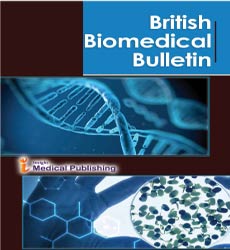ISSN : 2347-5447
British Biomedical Bulletin
Underlying Immunological Basis of the Various Asthma Endotypes
Hamida Hammad*
Department of Internal Medicine and Pediatrics, Ghent University, Ghent, Belgium
- *Corresponding Author:
- Hamida Hammad
Department of Internal Medicine and Pediatrics, Ghent University, Ghent, Belgium
E-mail:Hamida1996@yahoo.com
Received date: : July 06, 2022, Manuscript No. IPBBB-22-14500; Editor assigned date: : July 11, 2022, PreQC No. IPBBB-22-14500(PQ); Reviewed date:July 21, 2022, QC No IPBBB-22-14500; Revised date:: : July 29, 2022, Manuscript No. IPBBB-22-14500 (R); Published date:Aug 04, 2022, DOI: 10.36648/2347-5447.10.4.5
Citation: Hammad H (2022) Underlying Immunological Basis of the Various Asthma Endotypes. Br Biomed Bull Vol. 10 Iss No.4:005.
Description
Asthma is a chronic inflammatory disease of the airways leading to cough, wheeze, shortness of breath, and chest tightness. Asthma symptoms are driven by the inflammation of the airways, which triggers processes such as mucus production, remodeling of the airway wall, and Bronchial Hyper Responsiveness (BHR, which is the tendency of smooth muscle cells to react to non-specific stimuli such as cold air. Asthma often starts at a young age (childhood-onset asthma), but some patients can develop asthma later in life (late-onset asthma). Childhood-onset and late-onset asthma differ in many ways. Late-onset asthma is more severe and less associated with allergy than childhood-onset asthma. In children, atopy, lower-lung function, and respiratory-tract infections especially with rhinovirus, represent major risk factors for the persistence of asthma. Whether the underlying inflammation present in asthmatic children drives the pathogenicity of respiratory viruses or whether frequent viral infections at young age set the stage for asthma to develop is still not understood. Because inflammation is so central in asthma pathogenesis, it is not surprising that the primary goal of asthma treatment has been to achieve the control of symptoms and underlying inflammation to avoid future disease exacerbations.
Synthesis of Immunoglobulin E (IgE) by Allergen-Specific B Cells
Unsupervised clustering methodology to look at the disease course and clinical features of asthma has revealed that this is a heterogeneous disease, reflected by major patient-specific differences in age of onset, associated risk factors, and degrees of severity, comorbidity, and response to treatment. We also realize now that not all asthma patients have reversible airway obstruction, and persistent airway obstruction caused by airway-wall remodeling and mucus plugging of the airways is now seen as one of the biggest unmet medical needs of clinical asthma care. Historically, only two main forms of asthma have been identified: allergic and nonallergic asthma, but this has turned out to be an oversimplification. Allergic asthma tends to begin in childhood and is associated with T helper 2 (Th2) cell responses, which are also seen in other allergic conditions such as atopic dermatitis or allergic rhinitis. This form of asthma is induced by early life encounters with environmental allergens such as House Dust Mite (HDM), pollen, cockroach, or animal dander but can also be induced later in life when a new, e.g., occupational allergen, is encountered. Upon recognizing allergens, allergen-specific Th2 cells produce type 2 cytokines (interleukin [IL]-4, IL-5, IL-9, and IL-13), that lead to the accumulation of high numbers of eosinophil’s in the airway wall, mucus overproduction, and synthesis of Immunoglobulin E (IgE) by allergen-specific B cells, which can be detected in the serum or through a positive skin-prick test.
Clinical Studies Targeting Particular Pathways Using Molecule-Specific Biologics
In this review, we will focus on the underlying immunological basis of the various asthma endotypes, highlighting articles where authors imply causality through rigorous experimentation. We will discuss results obtained from animal studies in which molecular pathways have been unraveled in great molecular detail and results generated in clinical studies targeting particular pathways using molecule-specific biologics. Although the mechanisms and environmental risk and protective factors behind allergic sensitization in childhood are well understood and extensively modeled in mice (reviewed in, why the disease localizes to the airways, and persists into adulthood, is less clear. Disease onset coincides, however, with a very crucial period of immune system and lung structural development in early childhood. Lifelong homeostasis and susceptibility to immune-mediated diseases such as asthma are shaped during the neonatal period. Therefore, alterations in the lung environment during this window of opportunity could lead to changes in immune cell and organ behavior that persist long after the initial trigger is gone. In contrast to allergic asthma, non-allergic asthma is usually late onset, is more common in females and in obese patients, and can sometimes be very difficult to treat. Late-onset asthma phenotypes were classified into Th2 and non-Th2 late-onset asthma. The non-Th2 form is often associated with obesity, aging, and smoking.
Open Access Journals
- Aquaculture & Veterinary Science
- Chemistry & Chemical Sciences
- Clinical Sciences
- Engineering
- General Science
- Genetics & Molecular Biology
- Health Care & Nursing
- Immunology & Microbiology
- Materials Science
- Mathematics & Physics
- Medical Sciences
- Neurology & Psychiatry
- Oncology & Cancer Science
- Pharmaceutical Sciences
